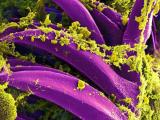May 2, 2002 (CIDRAP News) – A single gene change enabled a recent ancestor of Yersinia pestis to use fleas as its transmission vehicle, launching the process that changed a relatively benign microbe into the agent that causes plague, according to a study sponsored by the National Institutes of Health (NIH).
The study, published in the April 26 issue of Science, shows that an enzyme called phospholipase D (PLD), previously known as Yersinia murine toxin, allows Y pestis to survive in the midgut of the rat flea. By acquiring the gene that encodes PLD, "the bacterium gradually changed from a germ that causes a mild human stomach illness acquired via contaminated food or water to the flea-borne agent of the 'Black Death,' which in the 14th century killed one-fourth of Europe's population," the NIH said in a news release.
The researchers, led by B. Joseph Hinnebusch, PhD, of Rocky Mountain Laboratories in Hamilton, Mont., infected fleas with Y pestis variants that either contained or lacked the PLD gene, the NIH said. The authors found that the microbe can't survive in the flea midgut without the enzyme. "Intracellular PLD activity appeared to protect Y pestis from a cytotoxic digestion product of blood plasma in the flea gut," the article abstract states.
"The gene change allowed the bacteria to be transmitted through the bite of an insect—in this case, the flea—an adaptation that distinguishes Yersinia pestis . . . from all closely related, more benign gut bacteria," the NIH said. The researchers suggest that this adaptation to reliance on a blood-feeding host for transmission favored the emergence of more deadly bacteria strains, the agency said.
Previous research indicates that Y pestis acquired the PLD gene from either an unrelated bacterium or a simple nucleated organism, according to the NIH. The agency said the study "adds an important piece to understanding the forces behind the emergence of plague, which occurred within the past 1,500 to 20,000 years."
The molecular mechanism by which PLD protects Y pestis in the flea gut is not yet known. "To find that out is clearly the next step," Hinnebusch said in the NIH release. Rocky Mountain Laboratories is an outpost of the National Institute of Allergy and Infectious Diseases, part of the NIH.
Hinnebusch BJ, Rudolph AE, Cherepanov P, et al. Role of Yersinia murine toxin in survival of Yersinia
pestis in the midgut of the flea vector. Science
2002;296(5568):733-5
Abstract
(access for nonsubscribers requires free registration)
NIH news release
http://www.nih.gov/news/pr/apr2002/niaid-25.htm


















